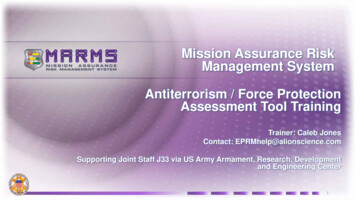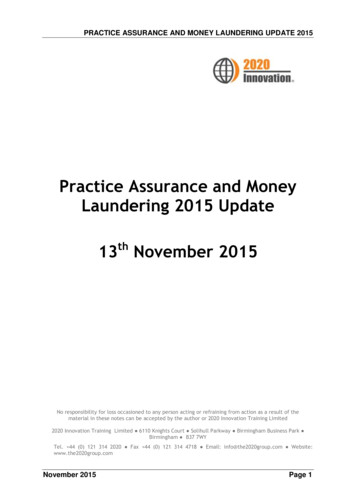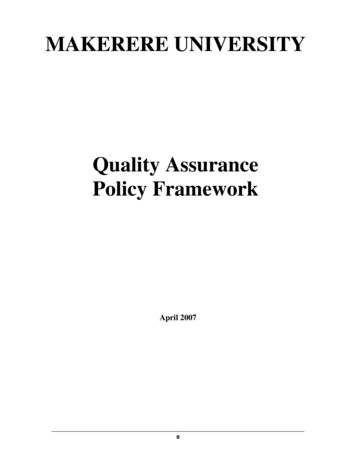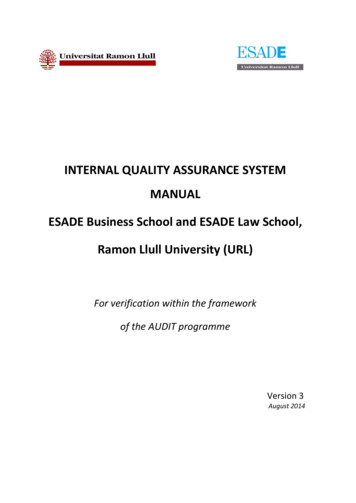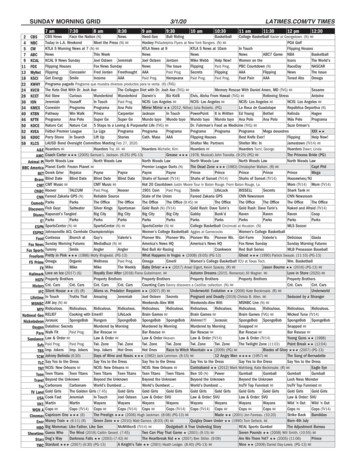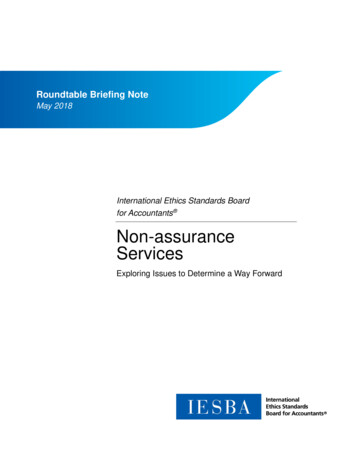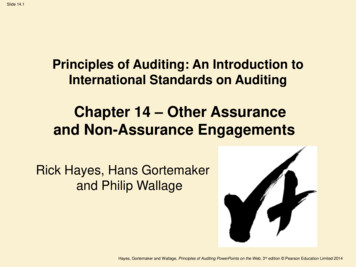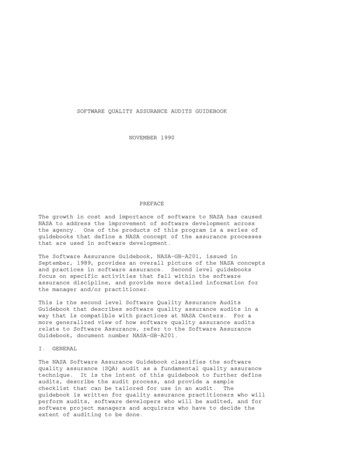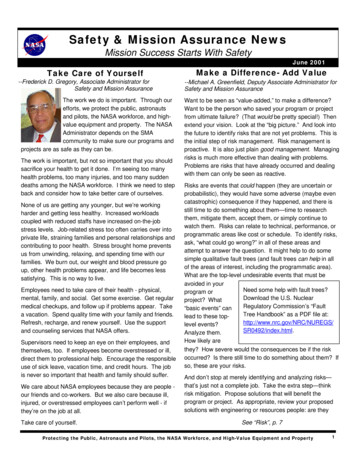
Transcription
Safety & Mission Assurance NewsMission Success Starts With SafetyJune 2001Take Care of Yourself--Frederick D. Gregory, Associate Administrator forSafety and Mission AssuranceThe work we do is important. Through ourefforts, we protect the public, astronautsand pilots, the NASA workforce, and highvalue equipment and property. The NASAAdministrator depends on the SMAcommunity to make sure our programs andprojects are as safe as they can be.The work is important, but not so important that you shouldsacrifice your health to get it done. I’m seeing too manyhealth problems, too many injuries, and too many suddendeaths among the NASA workforce. I think we need to stepback and consider how to take better care of ourselves.None of us are getting any younger, but we’re workingharder and getting less healthy. Increased workloadscoupled with reduced staffs have increased on-the-jobstress levels. Job-related stress too often carries over intoprivate life, straining families and personal relationships andcontributing to poor health. Stress brought home preventsus from unwinding, relaxing, and spending time with ourfamilies. We burn out, our weight and blood pressure goup, other health problems appear, and life becomes lesssatisfying. This is no way to live.Employees need to take care of their health - physical,mental, family, and social. Get some exercise. Get regularmedical checkups, and follow up if problems appear. Takea vacation. Spend quality time with your family and friends.Refresh, recharge, and renew yourself. Use the supportand counseling services that NASA offers.Supervisors need to keep an eye on their employees, andthemselves, too. If employees become overstressed or ill,direct them to professional help. Encourage the responsibleuse of sick leave, vacation time, and credit hours. The jobis never so important that health and family should suffer.We care about NASA employees because they are people our friends and co-workers. But we also care because ill,injured, or overstressed employees can’t perform well - ifthey’re on the job at all.Take care of yourself.Make a Difference- Add Value--Michael A. Greenfield, Deputy Associate Administrator forSafety and Mission AssuranceWant to be seen as “value-added,” to make a difference?Want to be the person who saved your program or projectfrom ultimate failure? (That would be pretty special!) Thenextend your vision. Look at the “big picture.” And look intothe future to identify risks that are not yet problems. This isthe initial step of risk management. Risk management isproactive. It is also just plain good management. Managingrisks is much more effective than dealing with problems.Problems are risks that have already occurred and dealingwith them can only be seen as reactive.Risks are events that could happen (they are uncertain orprobabilistic), they would have some adverse (maybe evencatastrophic) consequence if they happened, and there isstill time to do something about them—time to researchthem, mitigate them, accept them, or simply continue towatch them. Risks can relate to technical, performance, orprogrammatic areas like cost or schedule. To identify risks,ask, “what could go wrong?” in all of these areas andattempt to answer the question. It might help to do somesimple qualitative fault trees (and fault trees can help in allof the areas of interest, including the programmatic area).What are the top-level undesirable events that must beavoided in yourNeed some help with fault trees?program orDownload the U.S. Nuclearproject? WhatRegulatory Commission’s “Fault“basic events” canTree Handbook” as a PDF file at:lead to these tophttp://www.nrc.gov/NRC/NUREGS/level events?SR0492/index.html.Analyze them.How likely arethey? How severe would the consequences be if the riskoccurred? Is there still time to do something about them? Ifso, these are your risks.And don’t stop at merely identifying and analyzing risks—that’s just not a complete job. Take the extra step—thinkrisk mitigation. Propose solutions that will benefit theprogram or project. As appropriate, review your proposedsolutions with engineering or resources people: are theySee “Risk”, p. 7MissionStartsWith SafetyProtecting the Public, Astronauts andPilots,Successthe NASAWorkforce,and High-Value Equipment and Property1
Risk Based Acquisition Management (RBAM):Hate the name, but love the result--Phil NapalaRBAM is a procurement initiative that incorporatescontinuous risk management requirements into the NASAacquisition process.How many times have we complained that the SMAcommunity was not involved at the very beginning of aprogram or project? Time and time again, it seemed asthough projects were well underway before risks andsafety and assurance principles were seriouslyconsidered. RBAM fixes this in a direct basic way: followthe money. Procurement rules work differently than safetyand mission assurance rules. In procurement, you mustfollow all the steps or you can’t spend any money. So, wetied continuous risk management to getting the money.What drives RBAM is Procurement Notice 97-58, aNovember 2000 change to the NASA Federal AcquisitionRegulation (FAR) Supplement. The NASA FARSupplement is more stringent than NASA Policy Directives(NPD’s) or NASA Procedures and Guidelines (NPG’s):violations of the NASA FAR Supplement have criminalpenalties.PN 97-58’s main thought is simple. Program/project risksmust be discussed and evaluated throughout theacquisition process. Specifically, technical, schedule,cost, environmental and health, safety, security, resource(including personnel expertise), and unauthorizedtechnical transfer risks must be considered. Onceconsidered and identified, these risks shall be quantifiedas high, medium, or low during each acquisition phase.The results are typically shown on an acquisition stoplightchart, using red for high risk, yellow for medium, andgreen for low risk.The disciplined continuous risk management process thatwe are all familiar with is used to manage risk throughoutthe acquisition cycle:§ Identify. Sit individuals down, and point out troubleareas.§ Analyze. Engage brain, preferably before buying.§ Plan. Before leaping, think about where you’ll land.§ Track. Keep tabs on your bets.§ Control. Try not to do really stupid things.§Communicate. Be real when telling managers aboutrisks.§ Document. Write it down and don’t forget.To make it easier for everyone, we created specific RBAMtools and devices. All these tools and devices areavailable free of charge at the Glenn Research CenterRisk Management web page:http://www.grc.nasa.gov/WWW/spaceiso/rbamThe primary tool is the RBAM worksheet. The worksheetcan be used to start identifying program/project risk. Theworksheet is really a checklist to identify possible troublespots. The RBAM worksheet is a collection of general riskareas and mitigation strategies developed by acquisitionteams at NASA Centers. Using this checklist will result ina good first-cut risk list categorized in the risk areasspelled out in PN 97-58. After the first cut, the processcan vary, but these risks can be presented at the formalAcquisition Strategy Meeting, or become source selectionofficial backup material that supports award approval.How does RBAM help the SMA community? Most ofNASA’s acquisitions should have overall low safety andmission assurance risk. Inherent risk may be high, butapplication of normal, solid, well-defined processes cansatisfactorily mitigate risk areas. This is where the SMAcommunity can be invaluable. Imbedded into RBAM, thesafety and mission assurance disciplines can be used tomitigate major risks. Assurance programs can be addedto the Statement of Work to inspect, audit the risk areas,or to reliably test risky technical design solutions. In othercases, hazard analyses, quality parts programs, andsurveillance programs can be invoked to further reducepossible dangerous conditions.RBAM ties the money process to the safety and missionassurance process. Early application is showing practicalbenefit. Risks are being identified before announcementsare published. Risk discussions required by PN 97-58have been healthy reality checks as new, innovative, andtechnically challenging NASA project acquisitions come upfor review.Mission Success Starts With Safety2
The NASA EEE Parts AssuranceGroup--Michael J. Sampson, GSFC Code 306, and JeannettePlante, Dynamic RangeNASA’s technology advancement is leading to evermoresophisticated and autonomous spacecraft. Advances arelargely based on smaller, faster, more functional electronicdevices. Sophisticated software that makes the spacecraftlargely autonomous runs on these electronics. Electronicsare the nervous system of the spacecraft, the memory, thesenses, the “intelligence.” For the spacecraft to functionproperly, all of its electronic parts must function properly.The goal of electrical, electronic, and electromechanical(EEE) parts assurance efforts is to ensure a dependablesupply of highly functional and reliable EEE parts to NASAprojects. This responsibility has traditionally beendischarged by a combination of commodity specialists andproject support engineers. The project parts engineers(PPEs) call on the commodity specialists for detailed partsreliability information, application guidance and assistancein performing failure investigations, and finding alternativesources of supply or substitute devices.NASA recently realized that retirements and otherpersonnel actions had significantly drained the Agency’spool of commodity specialists. To reinvigorate EEE partsassurance processes across the Agency, OSMA formed theNASA Electronic Parts Assurance Group (NEPAG) in 2000with the support of the Office of the Chief Engineer (OCE).NEPAG is developing methods and tools to make the mostefficient use of the Agency’s parts engineering resourcesand maintain core parts engineering competencies.NEPAG is managed out of Goddard Space Flight Centerunder the leadership of Michael J. Sampson. Primarysupport comes from the lead parts engineers at ARC, JSC,MSFC, LaRC, GRC, KSC, and JPL. NEPAG also leveragesoff of partnerships with various Department of Defenseorganizations that have parallel and complementary effortsand requirements for high reliability parts in space systems.Representatives of the European Space Agency and theNational Space Development Agency of Japan provideinput for issues of global interest, such as the reliability ofcommercial parts in space and the drive towards the use oflead-free solders and plating for electronic systems.Nondestructive EvaluationWorking Group Supports NASAProgramsNASA’s Nondestructive Evaluation (NDE) program issponsored by OSMA and managed by LaRC with guidancefrom the NASA Nondestructive Evaluation Working Group(NNWG). The NDE program provides a focus for new NDEtechnology initiatives, documentation requirements, andcost-effective operating practices and processes to promoteNASA safety and mission assurance. The NDE program isshowing clear benefits to NASA programs and operations.For example, KSC is working to improve composite NDEcapability for accurate and precise detection of structuraldefects in bonded composites for Space Station and Shuttlehardware. Improvements will solve the recurring problem ofambiguous or incomplete NDE inspection results incomposites. Priority applications are composite Flight CrewSystem (FCS) components that replace metal components,and Spray-on Foam Insulation (SOFI) material for theexternal tank. Inspections on FCS pallets revealed internaldefects that had no visible external indications, andidentified the need for redesign of some components andchanged ground processing procedures. KSC and JSC areinitiating a program requirement for inspection using theseadvanced NDE techniques.MSFC and KSC are evaluating shearography techniques toinspect bonding between insulation and the Shuttle’sexternal tank. Results will demonstrate shearography’ssensitivity and accuracy to detect disbonds as well asprovide an implementation strategy for each Center’sshearography applications.Figure 1: InFOCuSapparatus worksbetter and costs lessthanks to an NNWGprogramSee “NEPAG”, p. 8GSFC is developing NDEtechniques to screen bulkquantities of cadmium zinctelluride that will be used in X-raydetectors for the InternationalFocusing Optics Collaboration forµCrab Sensitivity (InFOCuS)program. Two techniques weredeveloped to correlate bulkdefects to detector performance,leading to a nine-fold increase inproduction yield and improveddetector quality.See “NNWG”, p. 7Mission Success Starts With Safety3
2001 George M. Low Awards PresentedNASA Administrator Dan Goldin presented the 2001George M. Low Awards at the 16th Annual NASAContinual Improvement and Reinvention Conference onMay 10, 2001, in Alexandria, VA. The George M. LowAward is the premier quality and performance award in theaerospace industry. The award signifies NASA’srecognition that the recipient has demonstrated excellenceand outstanding achievements in quality and performance.The award is based on: Performance and Customer Satisfaction Schedule Performance Cost Performance Management Response to NASA's Goals Leadership and Continuous Improvement Innovation and Technology Breakthroughs Items of Special Interest to NASAAward winners must excel in each area. Winners werenamed in three categories: Large Business, Service Small Business, Product Small Business, ServiceRaytheon ITSS, Lanham, MD, nominated by AmesResearch Center, Goddard Space Flight Center, and theJet Propulsion Laboratory, received the 2001 George M.Low Award in the large business, service category.customers in a cost effective and responsive manner withprofessionalism and integrity." Swales has contracts withGSFC, JPL, and LaRC. Employees own 57% of Swalesthrough an Employee Stock Ownership Program. Recentmajor deliverables to NASA include: The integrated EO-1 spacecraft, Multi-segmented Mars Deep Drill demonstration unitfor JPL, FUSE telescope assembly, and 21-foot long integrated radiator/heat-pipe panel for theISS.Native American Services, Inc. (NAS), Huntsville, AL,nominated by Marshall Space Flight Center, received the2001 George M. Low Award in the small business, servicecategoryNAS is an onsite small disadvantaged business servicingMSFC’s Materials, Processes, and Manufacturing (MPM)Department. NAS performs exceptional work operatingthe Materials Combustion Research Facility andmaintaining the Materials and Processes TechnicalInformation System. NAS has 27 full-time employees andwas recently sold to Integrated Concepts & ResearchCorporation.Raytheon ITSS has a superior performance record,energetic management, and a commitment to outstandingperformance. All three Centers highly endorsed RaytheonITSS. The ITSS group has made considerable stridesadapting to Raytheon’s culture since being purchasedfrom Hughes in 1998. Raytheon ITSS has been able tofocus on customer needs through their 6 Sigmaphilosophy. The result is a focused contractor that makesthe right cost control decisions while meeting theircustomer’s expectations.Swales Aerospace, Beltsville, MD, nominated by GoddardSpace Flight Center, received the 2001 George M. LowAward in the small business, product category.Swales is an outstanding small business of approximately1000 employees. The company’s mission is to "provideworld class engineering and systems solutions to ourLeft to Right: Dr. Ashok Kaveeshwar, Senior VicePresident of Raytheon ITSS; Elmer Travis, President ofSwales Aerospace; Dr. Lajpat Utreja, President of NativeAmerican Services; and NASA Administrator Dan GoldinMission Success Starts With Safety4
2000 QASAR Winners RecognizedNASA Administrator Dan Goldin presented four “Best ofthe Best” Quality and Safety Achievement Recognition(QASAR) awards for 2000 at the 16th Annual NASAContinual Improvement and Reinvention Conference onMay 10, 2001, in Alexandria, VA. The QASAR awardprogram promotes quality, safety, and continuousimprovement throughout NASA. The award recognizesspecific contributors to NASA programs who havedemonstrated exemplary performance in contributing tothe quality and/or safety of products, services, processes,or management programs and activities. Winners arerecognized in four categories: NASA Safety and Mission Assurance organizationcivil servantsNASA civil servants outside the SMA organizationsNon-NASA civil servantsNASA contractorsCenters award local QASAR recognition and nominateone person for the annual “Best of the Best” QASARAward in each of the four award categories. The QASARAward Board then selects winners from the Centernominations.Jerry B. Holsomback of JSC’s International Space StationProgram Management Office received the award forNASA SMA organization employee. He has providedexceptional SMA leadership since the advent of theInternational Space Station program, and wasinstrumental in implementing and directing a probabilisticrisk assessment effort. As the focal point for SMA withinthe ISS Program Management Office, Mr. Holsombackhas provided crucial and decisive engineering andmanagement direction to NASA, its contractors, and theInternational Partners.Dr. George Sarver, III, of ARC’s Systems DevelopmentBranch and the Manager, Space Station BiologicalResearch Project (SSBRP), received the QASAR Awardfor NASA non-SMA civil servant. Dr. Sarver championedthe inclusion of accurate and verifiable SMA requirementsin the Mission Requirements Document for SSBRP, andauthored its first formal Risk Management Plan.Dr. Sarver’s distinguished SMA management andtechnical support significantly reduced risk and increasedthe probability of mission success for the SSBRP.Michael A. Pokorski, of the Grand Rapids office of theDefense Contract Management Agency, received theaward for non-NASA civil servant. During inspections at avendor, Mr. Pokorski identified problems with criticalhydraulic pumps for the Space Shuttle and recommendedchecking NASA’s inventory, including pumps installed onAtlantis, due for launch in less than a month on STS-106.Two pumps at the vendor’s plant and one on Atlantis hadthe same problems. Mr. Pokorski’s actions madesignificant contributions to the safety of STS-106 andsubsequent Shuttle missions.Dave Sheriff, calibration recall lead for the United SpaceAlliance at KSC, received the award for NASA contractor.Mr. Sheriff developed calibrations policies and processesto meet ISO 9001 requirements and led an activity tomatch calibrated tools and instruments to userorganizations, track usage, and identify under-used toolsand instruments that could be removed from thecalibration cycle. Mr. Sheriff’s success in reducing theinventory of calibrated tools has saved a minimum of 900,000 per year while reducing the instances wherenon-calibrated instruments are used for criticalmeasurements or verifications.The three civil servants each received 10,000 cashawards from NASA. Mr. Sheriff received a cash awardfrom United Space Alliance. For more information on theQASAR program, contact Geoff Templeton on (202) 3582157 or gtemplet@hq.nasa.govLeft to right: Dr. George Sarver III, DaveSheriff, NASA Administrator Dan Goldin,Michael A. Pokorski, and Jerry B.HolsombackMission Success Starts With Safety5
Continual Improvement Teams Present at 16th Annual ContinualImprovement & Reinvention ConferenceFive Center Continual Improvement (CI) Teams wereselected from Center nominations to make presentations atthe 16th Annual NASA Continual Improvement andReinvention Conference on May 10, 2001, in Alexandria,VA. The CI teams are groups who meet regularly toimprove work-related processes or problems by using astructured approach. The team may consist of any mix ofNASA civil servants and contractors. The team mustdemonstrate use of CI principles, techniques, and problemsolving/process improvement tools to improve productivityand quality (defects-per-unit, cost, cycle time,communication, and customer satisfaction) throughparticipation and teamwork. The selected teams were:Dryden Flight Research Center’s Hazardous MaterialManagement CI TeamIn 1993, DFRC’s hazardous waste generation was on therise, disposal costs were increasing, chemical managementwas a significant operational burden, and there was amandate to reduce hazardous waste generation by 50%.Through teaming with internal and external customers andstakeholders, the Safety, Health, and Environmental Officeand the Aircraft Maintenance Division developed a strategythat exceeded goals for improving DFRC’s chemicalmanagement process.Goddard Space Flight Center’s Landfill Gas UtilityService Acquisition TeamAs a result of an Executive Order that mandated reducedenergy consumption and increased use of renewablesources, Goddard investigated using landfill gas (methanegenerated by decomposing garbage at a landfill) as theprimary fuel for its steam boiler plant. The Acquisition Teamdetermined that there were no notable safety or operatingconcerns. Using landfill gas will save 1 million per year inheating costs and reduce emissions equivalent to removing100,000 cars from the roads. Based on these findings,Goddard has switched to landfill gas as its primary boilerfuel.Johnson Space Center’s Space Shuttle ProgramProcess Control Focus GroupThe Space Shuttle Program (SSP) Process Control FocusGroup (PCFG) addressed increasing process controlescapes that plagued the Shuttle program, causingschedule delays and mission problems. The team used CImethods such as root cause analysis, brainstorming, bestpractices, and sharing lessons learned to understand theproblems and develop techniques for improvement. Theteam developed process control standards, an SSP-widemanagement plan, and an awareness program forsuppliers. The PCFG is taking a long-term view to try toinfluence the culture of Shuttle suppliers and increaseprocess control. A key first-year product is the “Success inProcess Control” video giving examples of how minorprocess control escapes caused major problems. Thevideo also shows how individuals can catch processescapes. The video has been distributed widely to Shuttlesuppliers and received enthusiastic and positive feedback.Kennedy Space Center’s Hazardous MaterialsManagement Program TeamIn 2000, KSC launched the Hazardous MaterialsManagement Program (HMMP) to evaluate a pilot programat the Corrosion Control Facility, with a specific viewtowards implementing similar hazardous materialsmanagement across KSC. HMMP is addressingopportunities to: Reduce the accumulation of expired and damagedcontainers in storage, Minimize excess waste materials, Consolidate similar products, Evaluate and approve hazardous materials prior topurchase, and Provide a structured system to identify pollutionprevention opportunities.Marshall Space Flight Center’s Structural Loads TestMeasurement Acquisition System TeamThe Structural Loads Test Measurement Acquisition System(SLTMAS) is a highly customized data acquisition systemsupporting structural load testing of flight hardware. TheSLTMAS has been used on major flight programs for over35 years. The SLTMAS Team used continual improvementmethods to identify and implement means to improve thesystem’s capacity and capability; reduce upgrade,maintenance, and operations costs; reduce test schedulingand setup times; and speed up data analysis.The Administrator and senior managers judged MSFC’sSLTMAS Team to be the best presentation.Mission Success Starts With Safety6
“NNWG”, from p. 3GRC fabricated and tested a prototype silicon carbide(SiC) sensor for hydrocarbons. The sensor demonstratedgood sensitivity to propylene and ethylene and improvedlong-term stability. This sensor will be used to detect fuelleaks, and the technology will be applied to oxides ofnitrogen (NOx) and hazardous emission measurements.GRC also built a portable electronic holography system forborescope inspections of vibrating structures. The systemuses neural networks to provide real-time damageanalysis.thermographic inspection systems before they were usedon the RMAS.The Rapid Response Team is available to any NASAprogram that requires expertise in nondestructiveevaluation to solve problems. For more information on theRRT, contact Ed Generazio at (757) 864-4970 orE.R.GENERAZIO@LaRC.NASA.GOV. More informationon the NNWG and NDE in general can be found athttp://nesb.larc.nasa.gov/nnwg.html.KSC is assessing a variety of helium and hydrogen leakvisualization techniques for effectiveness and technologyreadiness. MSFC used advanced thermal signaturemethods to test the integrity of electrical wires in adamaged Solid Rocket Booster (SRB) cable bundle, andto identify and locate a leak on a Shuttle main enginenozzle after all other known methods failed.The NNWG also operates the Agencywide NDE RapidResponse Team (RRT) which provides on-demand, realtime NDE assistance for mission-critical problems. Oneissue the RRT worked on was evaluating the structuralintegrity of the Refurbished Manipulator Arm System(RMAS) at JSC after damage caused by a hydraulicfailure. The RMAS is a mission critical training system. ItFigure 2: Rapid Response Team’s thermal systemmeasuring the RMASsimulates use of the Shuttle’s robotic arm for building theInternational Space Station. Mission specialists on Stationassembly flights spend long hours training on the RMAS.The Rapid Response Team used a thermal measurementsystem from LaRC as well as ultrasonic spectroscopy andflash thermography systems from MSFC to inspectgraphite-epoxy booms in the RMAS. Data from thesesystems was critical to recertifying the RMAS for use.OSMA funded advanced development of theFigure 3: Post incident review, view of RMS elbow joint,looking towards the shoulder joint.“Risk”, from p. 1likely to work? AreFor safety risks (or hazards),they practical? Canproposed solutions shouldthey be done? Howfollow the order of precedencesoon; how muchin NPG 8715.3, “NASA Safetywould they cost?Manual;” i.e.,Are they worthwhile?1. Eliminate hazards.Consider what the2. Design for minimumrisks would be afterhazards.implementation—3. Incorporate safety devices.hopefully their4. Provide caution andprobability orwarning devices.severity will be much5. Develop administrativeless. If so, take yourprocedures and training.proposed solutionsto program/projectmanagement for decision. By extending your vision andtaking the extra step to risk mitigation, you can make areal difference. You can add real value. You might evenend up a hero!Mission Success Starts With Safety7
“NEPAG”, from p. 3The most effective way to deploy limited resources is tofocus on the areas with the most problems and concerns.NASA does not currently have a database to capture suchinformation. NEPAG was able to collect some data,primarily from one Center, showing the value of such adatabase. Figure 1, a Pareto diagram for the sources ofparts concerns from 1991 to 2000, shows the results fromone analysis. Seven types of devices represent 88% of theparts issues and should therefore get top priority for ourvaluable resources. NEPAG has begun to develop adatabase to capture parts problem experiences across theAgency; the data we have so far shows that parts problemsare not onnectorsDevice TypeCapacitorsRelayswebsite at http://eee.larc.nasa.gov/forum. The publicaccess segment provides general-use tools such as a riskassessment matrix for various grades of EEE parts. Thepassword-protected area is an interactive system to developtools and assist EEE parts engineers in their daily activities.Current tools include an informal discussion area, aninteractive calendar, and proprietary data such asmanufacturer test results, with future plans to add a vendorinformation database (delivery performance, problemincidences, takeovers mergers, process changes, etc.).The public access area will be expanded as productsdeveloped in the protected area are deployed.NEPAG will celebrate its first birthday in September. Wehave made a good start but much remains to be done, andmajor challenges such as the establishment of an Agencywide EEE parts information database lie ahead. Questionsregarding the NEPAG website should be addressed toLaRC/Otis Riggins at (757) 864-7944 orJ.O.Riggins@larc.nasa.gov, and general questions aboutNEPAG should be directed to GSFC/Michael Sampson at(301) 286-3335 or msampson@pop300.gsfc.nasa.gov, orto HQ/Tom Whitmeyer at (202) 358-2228 ortwhitmey@hq.nasa.gov.Wire & CableMagneticsFind Safety TipsPhotonicsCrystalsCircuit % of Total Problem ReportsGRC, KSC, LaRC, MSFC, and Headquarters produceperiodic safety tip sheets for Center distribution. The tipsare directed at personal, home, and workplace safety.Current and back issues of the safety tip sheets may befound ps/index.htmGRC: http://osat.grc.nasa.gov/safety/ (“Safety Links”)MSFC: http://www1.msfc.nasa.gov/STAR/KSC: http://aztec.ksc.nasa.gov/ecweb/LaRC: http://safety.larc.nasa.gov/Figure 1: A Pareto Diagram showing the percentagecontribution of various EEE parts commodities to the overall OSMA has developed an on-line index of the Center safetyrate of parts concerns.tip sheets, sorted by subject area, which includes a link toNASA parts engineers need automated tools to improve the the source document. Interested employees can search theindex for tips in specific areas. Those looking to incorporateefficiency of routine activities such as parts selection,safety tips into publications can search the index for existingreliability determination, review of historical data, failuretips rather than having to develop them from scratch.investigation, vendor assessment, and informationexchange. NEPAG is developing elements for a tool set toaddress these needs. The key element of this toolkit is theThe safety tip index can be found tips.htmMission Success Starts With Safety8
the initial step of risk management. Risk management is proactive. It is also just plain good management. Managing risks is much more effective than dealing with problems. Problems are risks that have already occurred and dealing with them can only be seen as reactive. Risks are events that could happen (they are uncertain or
